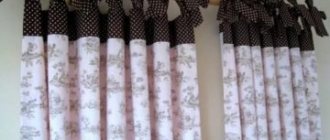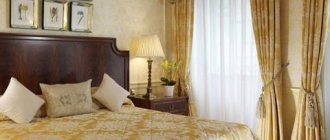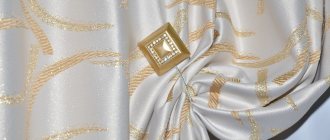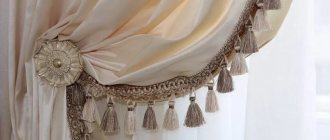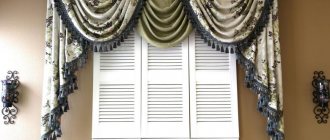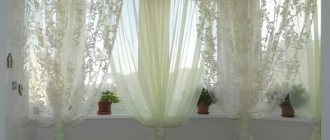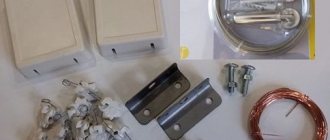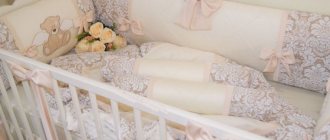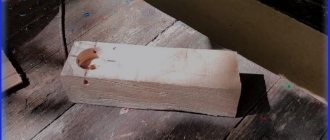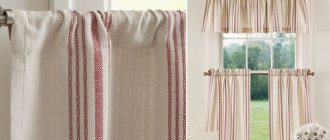French curtains are flowing lush folds and draperies. They are divided into sections. The folds run along the entire length and width of the curtains. A room decorated with such curtains immediately takes on a luxurious, majestic look.
French curtains will help place accents in the room, make it much cozier and more comfortable, and protect it from sunlight.
Window openings decorated with such curtains look chic and luxurious.
Curtain data history
Each thing has a history of creation, the country in which the product began to be produced. French curtains also have their own history of creation. It is believed that such curtains were first produced in France during the reign of Louis XIV. The 17th century is the era of classicism and baroque. Therefore, these curtains were widespread. French curtains hung on the windows of the houses of all the rich French kings, nobles, nobles, etc. But to this day they have not lost their popularity.
French curtains are fabrics decorated with many folds, which are located along the entire length of the product and remain on it, both in the raised and lowered position.
Fabric selection and style description
The choice of material is an interesting matter. For needlewomen this is a pleasure. But the main condition when choosing a fabric is its pliability. The appearance and shape of the drapery will depend on what material you choose:
- soft fabric of dense texture - falling waves;
- light and rigid material - lush frills.
Advice. Translucent fabric is perfect for the kitchen. The best option is organza. Silk and tulle can also be used to sew awnings.
The curtains received the name “awnings” due to their decorativeness and pomp. It is worth noting that this idea of decorating curtains became popular at the court of the French king Louis XIV.
French curtains are characterized by soft, uniform folds
They are often called cascade-lift curtains. They are made in the form of sections of fabric (festoons), which are connected vertically. Hence another name for them - scalloped. The scalloped fabric gathers into neat folds. The number of festoons depends only on your preferences, the dimensions of the window and, as a rule, is selected individually. Unlike standard curtains, awnings do not move apart, but are raised or lowered.
Attention! A good quality curtain rod system is the key to long and convenient operation. It can be manual or automatic.
Specific items you need to know
Main types of French curtains:
- Lifting. The most common option. They can be easily raised and lowered using modern systems and mechanisms. This allows you to easily open and close the opening without damaging the curtains. When raised, such curtains form beautiful and elegant lush folds. (Their length and width are strictly according to the size of the window opening!)
- Fixed. The window is constantly closed. They cannot be raised, lowered, moved left or right. These are curtains whose folds are fixed.
At the bottom of the curtains, cords pass through the loops, which, when pulled together, form scallops.
The canvases rise to the top, forming waves and lush voluminous folds.
Types of French curtains by size:
- Long. Quite a popular option for decorating a window and a room as a whole. Beautiful, lush draperies add a little chic and luxury to the room.
A classic and quite popular design option.
Important! This is an excellent option for rooms with a large area. Such curtains will emphasize the free space and become an elegant component of the room.
- Short. Basically, curtains of this length are chosen because there is a sofa standing near the window or when the window sill goes straight into the tabletop, etc. In these cases, hang short and comfortable French curtains.
Beautifully draped fabrics add special softness and sophistication to the space.
On a note! This is a great option for rooms with a small area. Visually, such curtains will expand an already small space. Also, short French curtains are often hung in the kitchen. This emphasizes the comfort and elegance in the room.
Step-by-step calculation of the required material
Before you start calculating, you need to decide whether the French curtain will be liftable. If she is entrusted with such a task, then such a product should have a length up to the window sill. Fixed window drapery may have other dimensions (for example, floor to ceiling).
Let's make calculations using the example of a short awning up to the window sill. We assume that the distance between the window sill and the cornice is 175 cm. The length of the cornice is 2 m:
- 2 m (length of cornice) x 1.5 = 3 m;
- 3 m (300 cm) + 4 cm (2 cm allowances on both sides) = 304 cm;
- 1.75 m (distance from window sill to cornice) x 2.5 = 4.375 m;
- 437.5 cm + 4 cm (for allowances of 2 cm at the top and bottom) = 441.5 cm.
Do you sew curtains yourself?
No. And I don’t plan to, it’s too difficult. No, but I would like to. Yes. With proper experience it is not difficult
To sew a short awning, in this case you need to take a piece of fabric with an average size of 3 x 4.40 m. But since working with a three-meter width can be difficult for beginning seamstresses, instead of one strip you can take 4 narrower ones (80 cm each). In this case, the material will have a width of 3.20 m and a length of 1.75 m.
The number of rings required to sew such a lifting awning is calculated according to the following scheme:
- L (length, in this case - 175 cm) - 15 cm (indent from the top to the first ring) - 5 cm (indent from the bottom to the last ring) = 155 cm;
- 155 cm / 12 cm (minimum distance between rings) = 13 pcs. (number of rings per 1 seam);
- 13 pcs. x number of seams.
Calculation of the number of rings required for sewing a lifting awning.
The length of additional cords is calculated as follows:
- L (curtain height, in this case - 175 cm) x 2 = 350 cm;
- 350 cm + D (length of the cornice, in this case 200 cm) = 550 cm (length of one cord);
- number of cords = number of seams.
Fabrics from which these curtains are made.
- Linen. This is an environmentally friendly material. Linen curtains are completely hypoallergenic. They look beautiful and elegant. Pleasant to the touch. After washing they do not settle and do not lose their original appearance. Only curtains made of this material are difficult to iron.
- Velvet. This material is especially pleasant to the touch. Its depth of color looks particularly luxurious. And because of the dense pile, such curtains have a beautiful play of light and shade.
The material is chosen based on the design features of the room.
- Veil. The material from which curtains give the room tenderness and romance. The veil looks great on its own or in combination with thicker curtains. French voile curtains look light, airy and relaxed. Therefore, such curtains will look great in the bedroom interior.
- Silk. French silk curtains shimmer beautifully in the light. They have an excellent play of colors when the sun's rays fall on them from different angles. This material is shiny, thin, but at the same time durable.
Awnings are made from well-draped materials in order to fully reveal their aesthetic capabilities.
- Organza. Curtains of this type made of organza will complement any interior. They look light, feminine, gentle, elegant, but at the same time simple and interesting. They are easy to care for, just like linen curtains.
- Atlas. Satin awnings (this is another name for French curtains) are very durable, with an incredibly smooth surface (sometimes this can turn against you, since puffs often form on a smooth surface).
Due to the reflection of light, all folds of French curtains shimmer and shine beautifully.
List of required materials
To sew French curtains, different fabrics are used: linen, voile, silk, velvet, satin, organza. You can choose another material, the main thing is that it fits well into the interior and copes with the functional responsibilities assigned to the curtains.
You need to prepare:
Textile
Special tightening tape (it can be replaced with Velcro)
Cords (their number is equal to the number of seams on the window drapery)
To sew a lifting awning, you need to additionally purchase special rings, their number is calculated individually. You will also need additional cords.
French curtains in the living room
The living room is a room for receiving guests, so it is important to pay special attention to the choice of all parts of the interior in this room. French curtains add a touch of tenderness and sophistication to the living room. And with such curtains you can decorate both a simple room and a luxurious interior.
Curtains bring a touch of romance and sophistication to this room.
Today, French curtains decorate both elaborate and simple living room interiors.
We sew decorations for the “eyes of the house” in the French style
It is impossible to imagine classic French curtains without a cornice covered with dense fabric; the better the materials used for this operation, the more expensive the item. The same tape that was used to install the canvas is perfect for covering the cornice; you just need to pull the cords out of it.
Hooks are sewn onto the tape covering the cornice, then French curtains are attached to them. After this, another tape must be attached to the assembly tape. Then the curtain is leveled and installed on the cornice.
Hooks attached to the canvas are screwed into the eaves beam. From bottom to top, cords are simultaneously pulled into the rings and the edges of those cords that are fixed at the top of the canvas are passed through the rings. All ends of the cords are brought to one side and pulled together so that the folds, which are the most important component of French curtains, are uniform.
French curtains in the nursery
Awnings will be an excellent, original and beautiful decoration for a children's room. These curtains are best suited for a girl's room. Especially if the entire interior of the room is in the style of classicism and baroque. But such curtains may not be the best option, because they collect a lot of dust.
Awnings will become an original, characteristic decoration and set the tone for the entire room.
How to prepare fabric for cutting
Before cutting and sewing the curtain, you must trim its edges, using a special braid to secure the curtain. The side and bottom edges simply need to be folded in half and stitched, then pressed. The edges need to be processed before sewing the curtains, since then they will be uneven and cannot be processed beautifully.
It is also necessary to iron all the material before starting sewing, and if it is difficult to iron, then this should be done two or three times. After sewing the curtain, it will not be possible to iron it, so this stage cannot be neglected, but it must be done efficiently. When the edges of the canvas have been processed and it is completely ironed, you can start cutting.
Awnings in the bedroom
Such curtains will add chic, tenderness, romance and splendor to the bedroom. With their simple and delicate design, the curtains will complement any style in the bedroom. You will be pleased to be in such a room. After all, French curtains set your body up for rest and sleep.
With their lyrical and delicate design, they create a special atmosphere and emphasize good taste.
Choosing the right fabric
In order for the folds to lie beautifully, and for the curtain to be light and slightly let in light, it is better to choose a soft translucent fabric. You need to consider what room the curtains are being sewn for.
The choice of fabric and model of French curtains depends on this. Curtains with lots of ruffles or flounces look romantic in the bedroom. In this case, the fabric is preferably pastel in color and should be soft so that it can drape easily.
The living room harmoniously combines light draperies and heavy curtains.
But awnings for the kitchen can be sewn from translucent organza. It is enough to keep the folds to a minimum. When everything you need is prepared, we get to work.
French curtains in the kitchen
The kitchen is such a cozy place where you can talk with family and friends over a cup of hot tea. It is best to hang short awnings in this room. French curtains in the kitchen will add pomp and at the same time lightness.
Both short curtains up to the window sill and long options will look appropriate here.
Awnings, with their lush and luxurious folds, will perfectly complement any kitchen interior and add charm, wealth and pomp to it.
How much to retreat, how to sew and where to pull?
After attaching the cord, the next step is to install the rings.
Modern fittings are made of metal and plastic. The first material is considered more durable, but for light curtains it is still better to choose plastic. The places where the rings are attached should be marked with chalk, a simple pencil or pins.
Beginners make a common mistake: the rings that are located at the bottom of the canvas are lowered very low. Correctly positioned lower rings of a French curtain will always be 5 cm higher than its edge. Another mistake is the distance between the rings being too large or small, or more precisely, between their rows.
The best option is a gap of 30 cm. It is also important to correctly measure the distance between the upper rings and the braid. The standard option is 12 cm - this is how much you need to retreat from the top edge of the fabric before you start sewing on the top row of fittings.
French curtains are perfect for a classic interior with antique furniture.
The process of attaching the rings themselves to French curtains is also important. Correctly fasten the rings with just a few stitches; only two knots are made on the thread. After sewing on all the rings, they proceed to pulling out the cords from the braid.
It is imperative to monitor the uniformity of the folds during this operation and correct it. As soon as the French curtains reach the required length for the window, they need to be fixed. To perform this operation, the cords are secured at the top edge and neatly tied together.
The size of the border should be equal to the length of the cornice. To prevent the knots of the cords from becoming too unfastened, it is necessary to take measures: the knots are tied as close as possible to the curtain fabric - and the problem is solved. All that remains is to cut off the excess sections of the cords and move on to the next stage of work - installation of the product.
How to sew these curtains with your own hands
Necessary materials:
- sewing machine;
- pins;
- scissors;
- soap or chalk;
- textile;
- threads to match the color of the fabric.
Awnings with their exclusivity will add a picturesque image to the interior of a certain style.
But before you buy fabric, you need to measure the window. The resulting width must be multiplied by one and a half, and the length by two. This result indicates how much fabric will be needed. But you still need to make seam allowances (2-3 cm).
French curtains are the embodiment of classics.
Operating procedure:
- First you need to process the edges of the fabric. Having spread the fabric on a smooth, flat surface (on a table or on the floor), make double folds (about 1 cm wide) on the sides and stitch them.
- Along the bottom edge you also need to make a double fold, but already 1.5 cm wide. Then stitch.
- The next step is to mark the scallops. Important! They need to be placed at an equal distance from each other across the entire width of the panel. (If you look at the table above, you can see that the width of the scallops directly depends on the width of the fabric. Therefore, based on the table, make markings).
- Then, using pre-prepared fabric, decorate the curtain drawers. To do this, sew these panels of fabric to the marking place (while bending them by 2-3 cm).
Graceful flowing accordion draperies will fit perfectly into any interior style. - You need to thread special cords into the finished drawstrings (you can use braid, ribbon or decorative rope to match the color of the curtains). Later, when the curtains are ready, you can use this cord to adjust the length of the curtains.
- Also, if you buy special rings, you can hang festoons on them. The rings are attached to the fabric at a distance of 15-20 cm from each other along the entire length of the panel.
- The cord should allow you to easily adjust the height of the curtain. When lifted, the scallops should form light and airy semicircular folds. A thick braid must be sewn to the top edge of the curtains. To use it to attach curtains to a rod.
- After securing the curtains to the rod/cornice, adjust the length of the curtains.
French curtains will add celebration, style, sophistication, elegance and splendor to the interior.
That's all! Luxurious DIY French curtains at home are ready!
Getting ready for sewing
There are many options on how to sew French curtains. Therefore, the first thing to do is determine what kind of curtains are needed. Light or dense, with or without a lifting mechanism. What length should it be and will it be necessary to move them along the cornice? Having clarified these points, you can begin preparation.
Choosing fabric
For curtains to look good, they must be sewn from plastic, soft textiles. One that fits well into folds, does not wrinkle or bulge. It's very easy to check. In the store you need to take the fabric you like and fold the edge. If they turn out to be rigid or the material does not hold its shape well, it is better to refuse the purchase. Lightly draped textiles can be purchased. It’s good if the material is easy to care for. This is especially important for items hanging in the kitchen or bathroom.
Suitable materials
- Veil. Transparent, very light material made from synthetic or natural threads. Drapes easily and retains volume. Plain fabrics are often complemented by prints, patterns or embroidery.
- Velvet. Textiles with dense pile of various heights, can be with an embossed pattern. Thanks to this, the color of the drapery is rich, with unusual tints. Velvet does not deform, retains its shape, and is difficult to care for.
- Silk. Dense soft textile with noticeable shine. Drapes easily and keeps its shape. Available in plain colors, with jacquard or printed patterns.
- Organza. Produced from natural and artificial fibers. It holds its shape well, although it can be a bit harsh. Lets light through and is difficult to wrinkle. It can be plain-dyed, printed, shiny or matte. It is chosen for stationary light models.
These are not all the fabrics from which French curtains can be made. Moiré, satinette, fine linen, satin and much more are suitable. The main thing is that the fabric drapes beautifully and does not wrinkle. In addition, you will need tape to secure the scallops. There is no need to save on it, otherwise the quality of the finished product will suffer. If the curtain is supposed to be raised, buy a special ribbon with rings for the cord.
Architect: Daria Vasilkova. Photo: Sergey Krasyuk
Instagram @simona_richi_textile
We carry out cutting
The pattern of French curtains is simple. There is no need to build it specially, it is an ordinary rectangle. To determine its dimensions, it is necessary to carry out calculations. Let's start with the width.
Calculate the length
In order for the curtains to look voluminous, it must be significantly longer than the length of the cornice. They calculate it like this. Measure the desired curtain width across the window and multiply the resulting number by a factor of 1.8. If you want the most voluminous product, you can increase the coefficient. We have given the average value.
In addition, to process the fabric you will need an allowance. Add another 6 cm, 3 cm on each side. Now you need to determine the number of scalloped stripes. Four is the minimum number, with less the product looks ugly. It's best if there are more of them. It all depends on the texture and density of the textile. The number of stripes is necessary to determine the width of the pleated block. To do this, the number obtained in the calculations minus the allowances is divided by the number of stripes.
On narrow windows, folded blocks with a width of 250-300 mm look good; for large windows, scallops of 500-600 mm are chosen. Take into account the thickness of the textile. For thin fabrics, narrow stripes are better, for dense ones - wide ones. All obtained values are written down on a piece of paper, and a pattern will be built from them directly on the material.
And width
The length of the fabric is determined based on the type of textile. For thin ones it should be larger, for dense ones less. In general, the desired curtain height is multiplied by two. For organza this coefficient can be equal to three, for veil and tulle 2.5. Additionally, add a few centimeters to allowances for processing the lower and upper parts.
You can make markings with your own hands directly on the panel. The only difficulty is the insufficient width of the material. Then you will have to connect the two strips. In this case, you need to make sure that the seam falls on the edge of the folded strip - where the drapery tape passes. Then it won't be noticeable.
The easiest way to sew French curtains with your own hands
Step by step instructions.
- You need to measure the window. The resulting width must be multiplied by one and a half, and the length by two. This result indicates how much fabric will be needed. But you still need to make seam allowances (2-3 cm).
- The purchased fabric should be soaked in warm water, wrung out, allowed to dry and ironed. All these procedures must be performed so that the fabric does not shrink in the future.
- Then you need to make a double fold (1-1.5 cm) and stitch all the edges.
The elegant design of French curtains goes perfectly with the simple and laconic interior of Provence.
- Mark the drawstrings so that there are equal spaces between them. Then on the front side you need to sew a special braid for French curtains (but if you don’t have one, you can use regular fabric 3 cm wide).
- A decorative rope/cord, ribbon or braid must be inserted into the side seams. Next, the drawstrings are formed. We fasten the cords at the top (you can stitch them), and there are free ends at the bottom. You can use the cord to adjust the height of the curtains.
- To keep the curtains vertical, you can sew in special weights.
Awnings will especially emphasize the freedom of style, create real comfort and add soft diffused lighting to the entire room.
That's all! This is the easiest way to create French curtains with your own hands!
How to choose colors
The color of curtains with folds can be chosen to suit your taste. The shade can be contrasting or combined with:
- design of walls, ceiling, floor;
- color of furniture facades;
- texture and shade of cornice for awning curtains;
- other textile elements.
A large print may be distorted due to folds; a small repeating pattern or a plain fabric is recommended. Tiny flowers, geometric patterns, and gold symbols look good.
Caring for French curtains
Of course, sewing such curtains with your own hands is only half the battle. The main thing is to properly care for them. Then French curtains will serve you for a long time. Awnings are truly beautiful curtains. They add luxury, richness, tenderness, and romance to the room. They have many advantages. But there are also disadvantages. The main and only disadvantage of such curtains is that a lot of dust often accumulates in the numerous folds.
French curtains have a fairly rich range of colors.
The presence of purple decor on the windows in the room stimulates inspiration and creative thinking.
- Small stains on curtains can be removed with a damp cloth.
- You can clean the folds of curtains from dust with a vacuum cleaner. Just be very careful!
- French curtains made of tulle and organza can be machine washed in the “delicate wash” mode.
- Velvet curtains should be dry cleaned.
- Such curtains cannot be ironed. It is better to hang them a little damp and they will take the desired shape themselves.
A well-chosen design will make the window in each room original and interesting.
A few finishing touches
And now the finishing touches remain: the cornice is installed above the window. If you remove the ribbons holding the French curtains, the curtain will lower. But first you need to adjust the tension so that the item is comfortable to use and lasts a long time.
The cords are connected into a knot. There is an important nuance here: the knot is tied so that it falls on the last hook. The cords are threaded through the lifting handle, 46 cm away from the first knot and another key curtain knot is tied.
The fastener is necessary in order to fix the desired position of the blade. To accomplish this task, a cord is wrapped around it. Only after this the curtain is considered fully secured.
Curtains sewn using French technology are a magnificent decoration in themselves, but they can be given an even more elegant look if you take care of decorating the product.
One of the options for decorating curtains is light rhinestones attached to their edges; they will create a play of light in the room. An equally interesting move is a lambrequin made of contrasting or plain fabric.
This combination of decorative items will look especially stylish in the living room.
If after making the curtains there is some fabric left, this is a great option to transform familiar interior items. For a sofa, for example, you can make a pillow decorated with festoons, and for a coffee table - a decorative napkin. Even a familiar blanket will change if its edging is done in the same color scheme as the curtains.
French curtains are a wide canvas, gathered into lush folds, the edge of which falls in folds. Curtains can consist of several sections or just one.
A window decorated with French curtains instantly transforms a room into a luxurious space. Usually soft folds of fabric are located evenly throughout the curtain. The window opening looks elegant and elegant.
Which color is better to choose?
The color scheme of the textile product depends on the surrounding decor. In this case, they start from the following interior elements:
- furniture;
- wallpaper;
- accessories.
Interior
In dark rooms it is preferable to use light French tulle, and in spacious rooms it is permissible to use different ones, including dark and heavy ones. To make the heat easier to bear in sunny weather, it is not recommended to use bright sunny colors of fabric for a south-facing window.
Advice: it is advisable to use a plain fabric or a canvas with a barely noticeable pattern, since a clearly defined pattern in a large number of folds is lost and ripples.
Specifics of care
The peculiarities of the location and fixation of folds require a very delicate approach when cleaning French curtains. The easiest way to clean is with a vacuum cleaner at the lowest power with a curtain or furniture attachment.
- Minor dirt can be removed using soap foam applied to a sponge.
- When washing, use the delicate cycle and first check whether they can be washed.
- Smooth with a steamer. If the curtains are made of complex fabrics, then it is better to entrust cleaning to specialists.
Features of fastening and finishing
Fastening. Static curtains are hung either on curtain rods of any design in order to be moved to the side, or on Velcro fastened directly to the window frame or a special curtain rod.
Lifting curtains are hung on a curtain rod with recesses for a cord that adjusts the height, or with a ready-made lifting mechanism.
Finishing
- The lambrequin will perfectly hide the hooks for attaching the curtain to the cornice and will serve as an ideal decoration
- Fringe is the best frame for heavy fabrics; it can be used to secure the drapery below.
- Tassels will complement the cord for fixing curtains that can be moved, and medium-sized tassels will complement the lambrequin or the bottom edge of the curtains.
- Bugle beads will decorate shiny fabric. If you sew large enough beads along the bottom, they will serve as a weighting agent, a balancing element, so that the curtains do not flutter from the flow of fresh air when the window is open, but retain their appearance
How to make a lifting awning
The curtain is ready. But it is static. If you need it to rise, do the following:
- Sew rings along all vertical seams, starting from the very edge and every 15 cm. The last ring in each vertical row is sewn 13-14 cm from the top of the curtain.
- After the rings are sewn, we take 5 more cords. Each of them is tied around the lowest ring and threaded through the rest of the rings in the row.
- Each cord is passed first through the vertical rings, then through the rings on the curtain rod, goes around it and hangs down to the bottom edge of the curtain.
- The free ends of the cords are braided. A hook is nailed to the wall, from the edge where the cords hang. When the curtain is raised, the cords are hooked onto it.
If you use a special curtain rod that already has cords, there is no need for the above steps.
The awning is assembled and all that remains is to hang it. Our curtain turned out to be universal. In the bedroom it can be used instead of boring classic curtains and combined and hung together with thicker curtains. In the living room and kitchen, use them as independent curtains and complement them with accessories: fringe, tassels, satin ribbons, decorative flowers.
